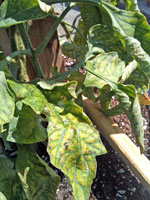7/28/2016
Growing With Griffin: Magnesium Deficiency: Clues & Cures
Rick Yates

Magnesium is the central element in chlorophyll, making it a crucial nutrient for maximizing photosynthesis, as well as maintaining vibrant green foliage. Like calcium, magnesium is required by plants in large enough quantities that it’s not considered a micronutrient, but rather a secondary nutrient. Only nitrogen, phosphorus and potassium (N, P, K) are needed in larger quantities by plants.
Given magnesium’s key role in chlorophyll production and function, it’s probably no surprise that one of the key symptoms of magnesium deficiency is an interveinal yellowing, often referred to as chlorosis. Other nutrient deficiencies can cause similar symptoms, so what can be done to determine if a magnesium deficiency is the source of trouble? The location on the plant where these symptoms are occurring is a strong clue.
Pictured: One of the key symptoms of magnesium deficiency is an interveinal yellowing, often referred to as chlorosis.
Some nutrients are very mobile in plants, with the ability for older, lower leaves to give up their bounty in order to supply the newly forming leaves at the growing tips of the plants. This group includes nitrogen, phosphorus, potassium and magnesium. With each of these mobile nutrients, it’s most common for deficiency symptoms to appear first on the lowest leaves, as nutrients are given up for the youngest growth.
Other nutrients are considered immobile, meaning that the more mature, lower leaves cannot give these nutrients up to supply the youngest leaves. In these cases, the deficiency symptoms appear first in the youngest foliage. Boron, calcium, copper, iron, magnesium and zinc make up this group. Iron deficiency symptoms, like magnesium, are often described as an interveinal yellowing. Observing the location on the plant where symptoms began can help you narrow down the possibilities between magnesium (lower foliage) and iron (upper foliage).
Magnesium is leached easily from soilless media, so it’s preferable to supply it on a continuous basis. The dolomitic limestone used in most mixes to adjust the pH does contribute some magnesium, and most, but not all, water-soluble fertilizers contain magnesium. The question is whether enough is being provided to optimize foliage color and plant performance.
To assess magnesium levels, consider the levels in both the media and the fertilizer water to determine if enough is being supplied to the crop on an ongoing basis. Water sources typically have at least some magnesium in them already. Be sure to take that into account, in addition to the amount provided by the fertilizer to determine if additional magnesium would be beneficial. For most crops, 30 to 50 ppm of magnesium in the irrigation water is sufficient (includes clear water and fertilizer).
Magnesium is safe even if provided at levels somewhat higher than what’s required, although large overdoses could lead to competition with potassium. Magnesium sulfate (i.e., Epsom salts) is an inexpensive source of water-soluble magnesium and is compatible with water-soluble fertilizers that don’t contain calcium. To aid in calculations, 1 oz. per 100 gal. of Epsom salts provides about 7.5 ppm of magnesium. For tank-mixing with fertilizers that do contain calcium, magnesium nitrate can be used instead. The rates are similar to Epsom salts, but the cost is somewhat higher.
Media analysis can be used to verify that your adjustments have been effective. A range of 40 to 100 ppm of magnesium is considered acceptable. Calcium levels should be two to three times higher than the magnesium, as a rule of thumb. Pulse applications of 8 oz. per 100 gal. of Epsom salts can be made to quickly correct a magnesium shortfall detected in the media analysis. The addition of Epsom salts will have a slight impact on the EC of your fertilizer solution.
Always read and follow the label directions. Not all products are labeled for use in all states. Products other than those listed here may also be safe and effective.
GT
Rick Yates is GGSPro Technical Support Manager for Griffin. He can be reached at ggsprotech@griffinmail.com.